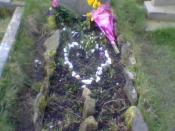In the poem 'Elm' by Sylvia Plath and the nonsense poem, "Jabbawocky" by Lewis Carroll, meaning is discovered by the poet's choice of diction, the imagery throughout the poem, the metaphors and their meanings and other poetic devices. Even the authors' background can influence the poem. These elements all contribute in creating a deeper understanding of the events occurring within the poem, meaning is found.
Many of Sylvia Plaths' poems have been described as 'gothic literature', and she too claims to be a 'female gothic'. The term gothic is still being studied and has much controversy of a set definition. In Plaths' poetry it's the reader has been given an alternative, darker meaning to that of their true meaning. The darker poetry some believe may be due to the time in which she was writing, time the world was recovering from the effects of war. (Fang 1).
Also 'Elm' deals with the narrators' personal experiences of madness, pain and depression and the poem has often been associated with Plath's personal experiences of these issues which are divulged in her autobiographical novel "The Bell Jar." Having an understanding of the authors' background and influences can change meaning within the poem. Elm opens with the sentence "I know the bottom, she says. I know it with my great tap rootâ¦I have been there." (Plath 192) This opening line can be related to several personal experiences of the narrator for example the fact that the narrator claims to "know the bottom with her great tap root," (Plath 192) This implies that the narrator knows the "bottom" of life, or the lowest point of depression. Also with the narrators "great tap root" (Plath 192), the roots of her existence are set in depression. This sentence also implies that...


